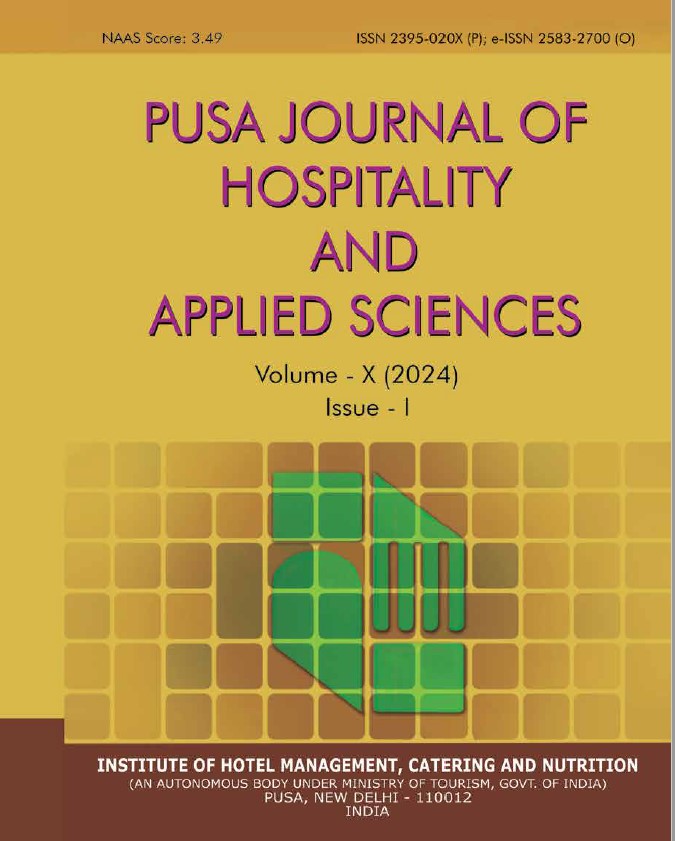From Root to Stem: Optimizing Produce Utilization and Reducing Waste through Sustainable Cooking Practices
DOI:
https://doi.org/10.48165/pjhas.2024.10.2.3Keywords:
sustainable cooking practices, root to stem concept, food waste, food sustainabilityAbstract
Background: In modern society, food waste is a pressing issue contributing to environmental degradation and resource depletion. “From Root to Stem” proposes a solution by advocating for sustainable cooking practices that maximize the use of every part of produce. Objectives: The objectives of this study were twofold. Firstly, to assess the existing levels of awareness and implementation of root-to-stem cooking practices among hospitality students. Secondly, to identify the obstacles hindering widespread adoption of root-to-stem cooking and to pinpoint the factors that facilitate its uptake. Additionally, the study aimed to propose effective strategies for promoting the incorporation of root-to-stem cooking practices in both domestic and commercial environments. Methodology: To accomplish these goals, a quantitative research approach, specifically employing a descriptive research design, was utilized. Data collection involved the use of an online questionnaire distributed via Google Forms among a select group of hospitality students with expertise in the kitchen. Convenience sampling was employed to gather data, resulting in a sample size of 328 participants. Data analysis was conducted using SPSS version 23, based on a mixed questionnaire format. Results: The data reveals that 92.1% of respondents are familiar with root-to-stem cooking. However, only 4.3% always incorporate these techniques, with 58.6% doing so sometimes. 87.4% have received formal education or training on root-to-stem cooking, and 78.1% believe it can contribute to reducing food waste. Additionally, 56.3% are moderately likely to explore root-to-stem cooking further in the future. Conclusion: Root-to-stem cooking offers a sustainable solution to minimize food waste by utilizing entire plants. Despite obstacles like limited consumer awareness and logistical challenges, collaborative efforts among stakeholders can drive its adoption. Through education, digital platforms, and policy interventions, root-to-stem cooking can revolutionize culinary practices and promote a more sustainable food system.
References
Abdou, A. H., Hassan, T. H., & Salem, A. E. (2023). Promoting sustainable food practices in food service industry: An empirical investigation on Saudi Arabian restaurants. Sustainability, 15(16), 12206. https://doi.
org/10.3390/su151612206
Anand, B. K., & Chaudhary, K. H. (2023). Exploring the relationship between corporate social responsibility (CSR) and sustainability and their transformative influence on social change. International Research Journal of Commerce, Arts and Science, 14(9), 154–162. http://www.casirj.com/abstractview/17881
Chaudhary, H. K., & Sharma, T. (2023). Efficient strategies for managing food waste in institutional catering: A comprehensive study. Pusa Journal of Hospitality and Applied Sciences, 9(2), 68–75. https://doi.org/10.48165/
pjhas.2023.9.2.9
Chaudhary, H. K., Singh, M., & Ghosh, P. (2024). Balancing Act: Achieving Carbon Neutrality in Star-Rated Hotels Through Net Zero Methodology and Responsible Tourism Practices. 337–360. https://doi.org/10.2991/978-94-
6463-437-2_24
Coskun, A., Genç, H. U., & Coskun, A. (2023). How sustainable is your menu? Designing and assessing an interactive artefact to support chefs’ sustainable recipe-planning practices. Proceedings of the 6th ACM SIGCAS/SIGCHI Conference on Computing and Sustainable Societies, 90–98. https://doi.
org/10.1145/3588001.3609366
Bose, D. & Chaudhary, H. K. (2023). Challenges and opportunities in scaling millet-driven cloud kitchen businesses: a comprehensive study. EPRA International Journal of Multidisciplinary Research (IJMR), 155–164. https://doi.org/10.36713/epra15143
El Bilali, H., Strassner, C., & Ben Hassen, T. (2021). Sustainable agri-food systems: Environment, economy, society, and policy. Sustainability, 13(11), 6260. https:// doi.org/10.3390/su13116260
How to Use Up All Your Fresh Produce, Root to Stem. (n.d.). Retrieved March 13, 2024, from https://www.realsimple. com/food-recipes/cooking-tips-techniques/root-to-stem cooking
Kansaksiri, P., Panomkhet, P., & Tantisuwichwong, N. (2023). Smart cuisine: Generative recipe & amp; ChatGPT powered nutrition assistance for sustainable cooking. Procedia Computer Science, 225, 2028–2036. https://doi.org/10.1016/j.procs.2023.10.193
Kumar, A., & Chaudhary, K. H. (2023). Empowering diversity: Role of artificial intelligence in promoting gender inclusion within the hotel industry. Social,Economic and Gender Inclusiveness in Tourism and Hospitality Industry, 2–11.
McKenzie‐Mohr, D. (2000). New ways to promote proenvironmental behavior: Promoting sustainable behavior: an introduction to community‐based social marketing. Journal of Social Issues, 56(3), 543–554. https://doi.org/10.1111/0022-4537.00183
Miyazawa, T., Hiratsuka, Y., Toda, M., Hatakeyama, N., Ozawa, H., Abe, C., Cheng, T.-Y., Matsushima, Y., Miyawaki, Y., Ashida, K., Iimura, J., Tsuda, T., Bushita, H., Tomonobu, K., Ohta, S., Chung, H., Omae, Y., Yamamoto, T., Morinaga, M., … Miyazawa, T. (2022). Artificial intelligence in food science and nutrition: a narrative review. Nutrition Reviews, 80(12), 2288–2300. https://doi.org/10.1093/nutrit/nuac033
Plakantonaki, S., Roussis, I., Bilalis, D., & Priniotakis, G. (2023). Dietary fiber from plant-based food wastes: A comprehensive approach to cereal, fruit, and vegetable waste valorization. Processes, 11(5), 1580. https://doi.
org/10.3390/pr11051580
Root To Stem: Eating Fruits & Vegetables With Peels, Stems, Leaves Is Now A Food Trend! - NDTV Food. (n.d.). Retrieved March 13, 2024, from https://food.ndtv.com/ food-drinks/root-to-stem-eating-fruits-vegetables-with peels-stems-leaves-is-now-a-food-trend-1799381
Root-to-Stem Cooking: How to Maximize Your Produce and Minimize Waste - Clean Eating. (n.d.). Retrieved March 13, 2024, from https://www.cleaneatingmag.com/clean living/greener-you/root-to-stem-cooking-maximize produce-minimize-waste/
Scherer, K., dos Santos, A., & Lilley, D. (2023). Design for sustainable behaviour: Guidelines for cooking appliances. Advanced Design Research, 1(2), 94–108. https://doi.org/10.1016/j.ijadr.2023.12.003
Vågsholm, I., Arzoomand, N. S., & Boqvist, S. (2020). Food security, safety, and sustainability—Getting the trade offs right. Frontiers in Sustainable Food Systems, 4. https://doi.org/10.3389/fsufs.2020.00016
Vizzoto, F., Testa, F., & Iraldo, F. (2021). Strategies to reduce food waste in the foodservices sector: A systematic review. International Journal of Hospitality Management, 95, 102933. https://doi.org/10.1016/j.
ijhm.2021.102933




